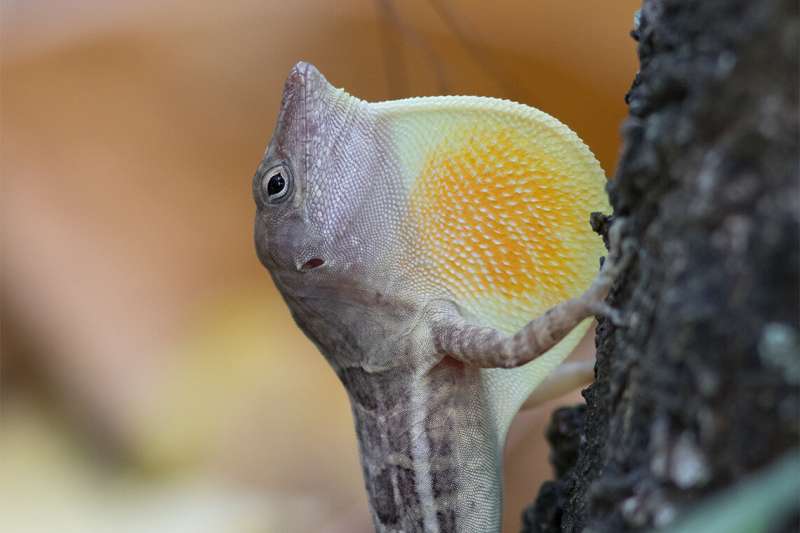This article has been reviewed according to Science X's editorial process and policies. Editors have highlighted the following attributes while ensuring the content's credibility:
fact-checked
peer-reviewed publication
trusted source
proofread
By studying lizards, researchers reveal the forces that shape biodiversity

"If you pick a spot in, say, a rainforest, and count the number of different species of lizards within 15 meters and you come up with a number," asks Luke Mahler, "what determines that number?"
Mahler is an assistant professor in the University of Toronto's department of ecology and evolutionary biology in the Faculty of Arts & Science. He studies how the interplay of ecological and evolutionary forces over time and space results in the biodiversity we see in different habitats. He does this primarily by studying Anolis lizards—aka anoles—small, tree-dwelling reptiles in tropical regions of the Americas.
What determines the number of different species in local communities of animals? The question is a long-standing ecological problem for which there has been no consensus.
"Is it because of local processes like competition for food or territory?" Mahler asks. "Or is it the result of broader, regional processes like the generation of new species by evolution?"
One hypothesis suggests the determining force is local competition. In other words, if a local community—for example, a particular patch of forest on a tropical island—is "full up" with several species, then additional species wouldn't be able to persist because every ecological niche is already occupied.

But according to another hypothesis, the diversity of species in such an area isn't limited by a pre-existing number of niches. Instead, the most important factor determining the number of species in a local community is the diversity of the broader region.
"On an island with a small total number of species, local communities should have only a small number of species," Mahler explains. "But on an island that has many species, you should see many species in local communities. In other words, local diversity is essentially a reflection of broader diversity, with classic ecological processes like competition mattering very little.
"If regional diversity determines what you see at a local site, then that local diversity is ultimately determined by the large-scale evolutionary processes that created the regional diversity."
To answer the question of local versus regional, Mahler and his colleagues studied anoles on the Caribbean islands of Jamaica and Hispaniola. What the researchers found was evidence for an unexpected third option—one that required marrying elements of both the "local" and "regional" hypotheses.
They found that the diversity of species in local communities indeed seems to be determined by local ecological processes that cap species diversity—but only if regional evolutionary forces have already produced the kinds of species that can monopolize local ecological resources. For example, the rich evolutionary diversity of species on Hispaniola, a large and ancient island, has "fed" a wealth of specialized species into the local communities at higher elevations on that island.
Why? Hispaniola's diversity—which stems from evolution playing out over millions of years across a very large and complex area—has led to unique anole species that exist only in the highlands. These species have filled all the available ecological niches, precluding more species from joining local communities there.
In contrast, Jamaica is smaller in area, especially in the highlands. And while many anole species have evolved on the island, the relative lack of space in the highlands hasn't allowed the evolution of new highland-specialist species as it has on Hispaniola. In fact, there is only one distinct highland anole in Jamaica.
Put another way, local diversity is determined by both regional and local forces but in different ways. Regional forces produce a diverse set of species, which then compete with one another, establishing local limits on diversity in any given location. But if a region is lacking in "evolutionary opportunity" because it's too small or too young, it fails to produce a diverse assembly of species and local limits are never reached.
Mahler and his colleagues described these findings in their study, published recently in the journal Ecology Letters. Co-authors included Luke Frishkoff, who started working on the research as a post-doctoral researcher in Mahler's lab and who is now an assistant professor at the University of Texas at Arlington, and Gavia Lertzman-Lepofsky, a Ph.D. candidate currently in Mahler's lab.
The "laboratories" in which Mahler and his colleagues conducted their research—Jamaica and Hispaniola—were chosen because they are similar in many ways. They are situated at the same latitude, have matching topography and have similar forest habitats.
Every summer from 2016 to 2018, the researchers counted the number of anole species in dozens of 30-meter diameter plots on both islands from sea level to an altitude of approximately 2,000 meters.
"The anole faunas of Jamaica and Hispaniola provide a rich opportunity for comparison because they represent a natural experiment," Mahler says. "And what we found is that local processes do matter. But they matter in such a way that it's regional opportunities for diversification that determine their strength."
"However, this is a single, if illustrative, comparison. Determining the generality of the evolutionary opportunity model we propose here awaits additional tests."
More information: Luke Owen Frishkoff et al, Evolutionary opportunity and the limits of community similarity in replicate radiations of island lizards, Ecology Letters (2022). DOI: 10.1111/ele.14098
Journal information: Ecology Letters
Provided by University of Toronto

















